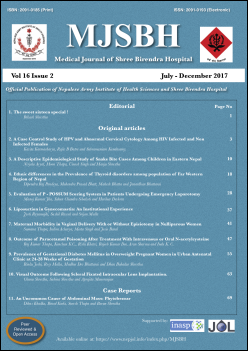Visual outcome following scleral fixated intraocular lens implantation
Keywords:
Aphakia, astigmatism, scleral fixated intraocular lensAbstract
Introduction: Scleral fixated intraocular lens(SFIOL) implantation to correct aphakia offers superior visual rehabilitation in comparison to aphakic spectacles or contact lens. This study was done to evaluate a simplified technique of scleral fixation of posterior chamber intra-ocular lens (IOL) in terms of visual outcome and complications.
Methods: This was a prospective study enrolling 23 eyes of 23 patients who underwent anterior vitrectomy followed by ab-externo sclera fixation of posterior chamber IOL using 10.0 polypropylene sutures from January 2016 to February 2017 in Nepal Eye Hospital.Scleral flap was made at 3 and 9'o clock meridian to cover the knots which prevent erosion of the knots through conjunctiva. Main outcome measures were post-operative best corrected visual acuity and post-operative complications.
Result: Best corrected visual acuity were 6/6 - 6/18 in 86.9% (n=20), 6/24 - 6/60 in 8.7% (n=2) and worse than 6/60 in 4.3% (n=1)at six months followup. The mean spherical equivalent before surgery was +10.60 diopter and -1.14 diopter post-surgery. The common indicationsfor scleral fixated intraocular lens weretrauma in 60.86% (n=14), surgical aphakia in21.73% (n=5), spontaneous posterior dislocation of lens in 13.0% (n=3) and subluxated intraocular lens in 4.34% (n=1). The common complications were astigmatism in 91.30% (n=21), decentered IOL in 4.34% (n=1) and uveitis in 4.35% (n=1).
Conclusion: Ab-externosclerated fixated intraocular lens is a safe and effective method for visual rehabilitation with low post-operative risk.
Downloads
Downloads
Published
How to Cite
Issue
Section
License
This license enables reusers to distribute, remix, adapt, and build upon the material in any medium or format for noncommercial purposes only, and only so long as attribution is given to the creator.




